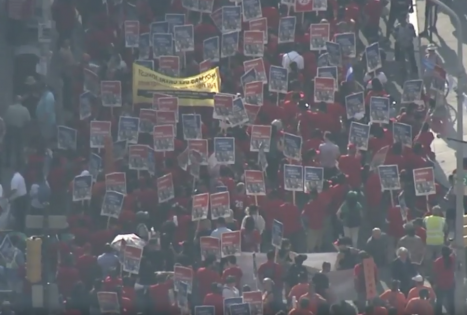
Nurses, medical workers, and family members picket, Tuesday, July 24, 2018, in front of Hasbro Children’s Hospital, in Providence, R.I. (AP Photo/Steven Senne) The Associated Press
Two different Nurses’ unions struck hospitals in Burlington, VT and Providence, RI for higher wages and better staffing. Both strikes were called for two days to demand hospitals negotiate in good faith to improve nurses’ wages in order to improve staffing levels for better patient care.
Nurses at two Rhode Island hospitals, Hasbro Children’s Hospital and Rhode Island Hospital, which are next door to one another, went on strike Monday, July 23, 2018, after negotiators couldn’t agree on contract terms during a meeting requested by a federal mediator. Local 5098 of the United Nurses and Health Professionals (UNAP) called the two-day strike of 2400 nurses and other hospital employees to demand that the owner Lifespan stop delaying. The union may take another vote to authorize an extended strike at Rhode Island Hospital if it becomes necessary. Negotiators meet again Aug. 8.
In negotiations following a two-day strike July 12 and 13, the Vermont Federation of Nurses and Health Professionals and representatives of the University of Vermont Medical Center in Burlington reached tentative agreements on issues that help govern some scheduling issues and pay rates. Both sides say the first agreements are good steps.
The two sides did not reach an agreement on pay increases for the 1,800 nurses. The union insists that higher wages are necessary to recruit and retain nurses and support staff and alleviate understaffing. Additional bargaining sessions are planned August.
What follows is an excellent article on the Burlington strike that will shortly appear in Labor Notes by Jonah Furman, used by permission of Labor Notes.
Vermont’s Striking Nurses Want a Raise for Nonunion Workers Too
by Jonah Furman
Especially for professional workers, when your main strike issue is pay, attracting public support can be a challenge.
Savvy employers paint union members as spoiled. They like to point out that you’re already making more than many of your nonunion neighbors.
Yet when 1,800 nurses and technical staff struck for better wages July 12-13 at the state’s second-largest employer, the University of Vermont Medical Center, the people of Burlington came out in force to back them up.
“We had policemen and firefighters and UPS drivers pulling over and shaking our hands” on the picket line, said neurology nurse Maggie Belensz. “We had pizza places dropping off dozens of pizzas, giving out free ice cream.”
And when a thousand people marched from the hospital through Burlington’s downtown, “we had standing ovations from people eating their dinners,” she said. “It was a moving experience.”
One reason for such wide support: these hospital workers aren’t just demanding a raise themselves. They’re also calling for a $15 minimum wage for their nonunion co-workers, such as those who answer the phones, mop the floors, cook the food, and help patients to the bathroom.
RED FOR MED
Restructuring in 2011 created the University of Vermont Health Network, an association of six hospitals, a visiting nurse association, and various clinics spread across the state and reaching into upstate New York.
But this hospital is the crown jewel, the state’s only Level I trauma center. As a “tertiary care” facility, it gets the network’s sickest and hardest-to-treat patients.
Funneling those patients to UVM Medical Center is a good thing, says surgical and pediatric intensive-care nurse Jason Winston, who has worked there a decade. “However, because the job has changed, we need the tools to do the job,” he said. “We need more staff, and wages that allow us to recruit and retain.”
Instead, the hospital struggles with a perennial nurse shortage. Winston said UVM doesn’t even match the wages at Champlain Valley Physicians Hospital, 30 miles away in Plattsburgh, New York—where the cost of living is much lower. And Champlain Valley sends its highest-need patients to UVM for specialized care.
FIGHT FOR $15
A bargaining survey of nurses and technical staff revealed that wages were a major concern—but with a twist. Members didn’t just want to boost their own wages. They wanted a raise for the nonunion secretaries and support staff, too. The Vermont Federation of Nurses and Health Professionals represents less than a quarter of the hospital’s workforce.
Vermont legislature passed a $15 minimum wage in May, but the governor vetoed it. Nurses knew that UVM Medical Center had the funds to raise its own minimum wage to $15—and the union had the will to fight for it.
While the union can’t officially negotiate wages for titles not covered in the contract, there is a provision that states that the hospital “shall provide sufficient ancillary staff so as to ensure that such duties do not fall to bargaining unit employees.” Chronic short-staffing should be addressed by raising wages to attract and retain support staff, says the union.
The union hosted a community rally in May focused on the low-wage licensed nursing attendants, who start at under $13 an hour. “LNAs are essential to our work,” says Belensz. “They’re taking patients’ vital signs, they’re helping to reposition patients to prevent bed sores, they help toileting patients. They’re our right-hand man.”
But, she adds, “More so than nurses even, LNAs are constantly short-staffed. Then we have nurses doing LNA duties, on top of the nursing workload.”
At the rally, 600 nurses and community allies marched through Burlington’s downtown, and then to the site of offices that are being built with UVM Medical Center as the anchor tenant. The hospital has agreed to pay annual rent that’s a million dollars higher than market rate, “for the health of downtown,” said Winston.
“Which is great, we want a healthy downtown. But if there’s money for that, and money for executive salaries, there’s money for nurses too.”
BRING A CROWD
Union members spent a year and a half building up to this two-day strike. The focus was on building as big a team as possible, not just union leaders.
In the union’s bylaws, each nursing unit at the hospital is entitled to elect at least one negotiating committee member, and large units get more than one. This produced a big bargaining team of 36 people. Even if you’re not on the bargaining team, you’re encouraged to sit in on negotiating sessions.
Whenever possible, the union brings a crowd:
- For the initial delivery of the union’s notice of intent to bargain—often a low-key administrative matter—100 nurses came out to deliver the forms.
- Close to 400 nurses showed up for the first bargaining session.
- In June, 1,300 members cast ballots in a strike authorization vote; 94 percent voted to strike.
- At the last bargaining session before the strike, hundreds of red-shirted nurses walked in, chanting “Safe staffing saves lives,” and “Hey Brumsted, what do you say? How many beds did you make today?” targeting the hospital’s CEO, who made more than $2 million dollars in 2017.
BIG PICTURE
Belensz, who has worked at the hospital for three years, was tapped to join the Member Action Team. That meant she was responsible for activating her co-workers in neurology—no easy task. Her unit hasn’t been much involved in past negotiations.
Day-to-day conditions in neurology are tolerable, and the managers are seen as fair. “There were a lot of people that were on the fence, or fully against the strike,” Belensz said. So her goal was to get them thinking about the bigger picture, especially the issue of short-staffing and overwork in other departments, like orthopedics and urology, where support staff are few and far between, and the nurse-to-patient ratio is much worse.
For her the rallies, marches, and open bargaining were crucial as “unifying events,” she said, that worked to “get people excited and show the hospital that we’re not messing around.”
The momentum grew as the strike deadline drew near. “We’ve made leaps and bounds in the last month,” Belensz said. She attributed that to the hundreds of one-on-one conversations and question-and-answer sessions the Member Action Team has held round the clock for months.
In fact, she was pleasantly surprised to see many of the former holdouts walking the picket line. One co-worker, who Belensz is sure voted no a month ago, told her, “If we need to strike again, we’re striking again!”
Filed under: Health Care, Solidarity, Strikes and work action, Uncategorized, Women | Tagged: Burlington, Federation of Nurses and Health Professionals, Health Care, Jonah Furman, Labor Notes, nurses, Providence, United Nurses and Health Professionals, Vermont | Leave a comment »






 Trade officials are racing to complete their renegotiation of the North American Free Trade Agreement (NAFTA) within the coming weeks — and, not suprisingly, corporate lobby groups are pushing hard to ensure that NAFTA provisions that make it easier to outsource jobs, drive down wages and pollute the environment are maintained.
Trade officials are racing to complete their renegotiation of the North American Free Trade Agreement (NAFTA) within the coming weeks — and, not suprisingly, corporate lobby groups are pushing hard to ensure that NAFTA provisions that make it easier to outsource jobs, drive down wages and pollute the environment are maintained.





